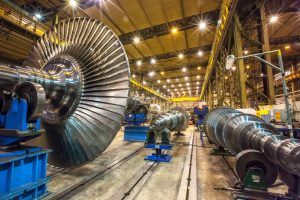Types of turbomachinery testing

Among the key turbomachinery tests are mechanical run test, string test, full load full pressure test and the verification test.
Below are excerpts from a paper "Shop rotordynamic testing -- Options, objectives, benefits and practices" by John A Kocur and C Hunter Cloud presented at the third Middle East Turbomachinery Symposium.
The mechanical run test as required by API is primarily a vibration level check. Measured at the probes located at the journal location, vibration levels are checked against the specified limit for both overall and non-synchronous components. General mechanical performance is also examined including bearing temperatures, close clearance rubbing and seal performance typically up to maximum continuous speed (MCS). Supercritical behavior is examined by determination of the amplification factor and separation margin of typically the 1st critical speed. (Obviously, the behavior of modes above MCS remains undetermined.)
The string test is not much different than the mechanical test mentioned previously. As the name implies, the string test is performed with all or a major portion of the machinery train connected (typically everything but the driver.) The objectives of this test are also similar to the mechanical test of a single body in that vibration levels are checked against limits, mechanical performance is examined, and supercritical behavior is analyzed. However, in this case, these are determined for the coupled train configuration. The string test is run to measure the coupled body dynamic behavior (when rigid couplings are used in the train) or the coupling spacer dynamics (for couplings with unusually long or heavy spacer tubes.)
Full load / full pressure tests are rarely performed based on rotordynamic justifications only, mainly due to the costs involved. However, the Type I test does permit vibration level checks at operating conditions, stall determination, impact of internal loading and deflections on dynamic behavior of individual components (seals and bearings) and a binary check for stability (yes or no). Range testing is rarely done during the Type I test.
Typically gas properties are held constant, clearances are left at as-built values and alternate configurations are not considered. Thus, while some aspects of rotordynamic behavior are tested, margins and robustness are left unchecked. The machines undergoing these tests leave those factors to analytical studies whose accuracy may remain unchecked. Keep in mind, to predict the stability (stable vs. unstable) of any machine is the first step in developing a good predictive tool. However, it is not the only step. As designs extend the operating or design experience, it becomes necessary to predict the stability threshold, separation margins and overall optimization of the design correctly, thus the need for verification testing.
The likely first attempt to publish a verification test in an industry standard was the unbalance response verification test published by API 617. The objective was simply to verify the unbalance response prediction accuracy of the vendor’s rotordynamic analysis with regards to the machine’s unbalance sensitivity within the operating speed range and the location of the critical speeds (below trip speed.)
The verification test analyzes both the predictor tool and model employed. A methodology was refined over several editions of API 617 within the limitations of the mechanical shop test. Alternatively, performing this test in the balance bunker has gained acceptance with the increase in at-speed balancing of rotors and the freedom it permits in terms of weight placement and additional measurement points. Stability Several methods have been developed analogous to the API unbalance response verification test with the objective to verify the stability predictions of centrifugal compressors. As with the unbalance response, the intent is to measure more than just “is the compressor stable” but “how stable is it.” The measurements are then compared against the analytical predictions to determine accuracy. Pettinato et al. [9] presented a methodology employing this test during mechanical and performance testing (as required by API 617).